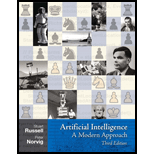
Give the name of the
- a. Local beam search with k = 1.
- b. Local beam search with one initial state and no limit on the number of states retained.
- c. Simulated annealing with T = 0 at all times (and omitting the termination test).
- d. Simulated annealing with T = ∞ at all times.
- e. Genetic algorithm with population size N = 1.
Explanation of Solution
a.
The local beam search with “k=1” is hill-climbing search.
b.
- Local beam search with one initial state and no limit on the number of states retained resembles with Breadth-First search.
- In breadth first search, before adding the next layer it adds one complete layer nodes.
- Starting from one state, the algorithm would be essentially identical to breadth-first search except that each layer is generated all at once.
c.
Simulated annealing with “T=0” at all time:
- There is a fact that termination step would be triggered immediately. Ignoring this fact, the search would be identical to first choice hill climbing.
- This is because; every downward successor would be rejected with probability 1.
d.
Simulated annealing with “T = ∞” at all times is a random-walk search, it always accepts a new state.
e.
Generic algorithm with population size “N=1”:
- The two selected parents will be same individual, if the population size is “1”.
- The crossover yields an exact copy of individuals. Here, the mutation chance occurs.
- Thus, the algorithm executes a random walk in the space of individuals.
Want to see more full solutions like this?
Chapter 4 Solutions
Artificial Intelligence: A Modern Approach
Additional Engineering Textbook Solutions
Starting Out with Python (4th Edition)
Java How to Program, Early Objects (11th Edition) (Deitel: How to Program)
Web Development and Design Foundations with HTML5 (8th Edition)
Starting Out with Java: From Control Structures through Objects (7th Edition) (What's New in Computer Science)
Problem Solving with C++ (10th Edition)
Management Information Systems: Managing The Digital Firm (16th Edition)
- using r language Obtain a bootstrap t confidence interval estimate for the correlation statistic in Example 8.2 (law data in bootstrap).arrow_forwardusing r language Compute a jackknife estimate of the bias and the standard error of the correlation statistic in Example 8.2.arrow_forwardusing r languagearrow_forward
- using r languagearrow_forwardThe assignment here is to write an app using a database named CIT321 with a collection named students; we will provide a CSV file of the data. You need to use Vue.js to display 2 pages. You should know that this assignment is similar, all too similar in fact, to the cars4sale2 example in the lecture notes for Vue.js 2. You should study that program first. If you figure out cars4sale2, then program 6 will be extremely straightforward. It is not my intent do drop a ton of new material here in the last few days of class. The database contains 51 documents. The first rows of the CSV file look like this: sid last_name 1 Astaire first_name Humphrey CIT major hrs_attempted gpa_points 10 34 2 Bacall Katharine EET 40 128 3 Bergman Bette EET 42 97 4 Bogart Cary CIT 11 33 5 Brando James WEB 59 183 6 Cagney Marlon CIT 13 40 GPA is calculated as gpa_points divided by hrs_attempted. GPA points would have been arrived at by adding 4 points for each credit hour of A, 3 points for each credit hour of…arrow_forwardI need help to solve the following case, thank youarrow_forward
 C++ Programming: From Problem Analysis to Program...Computer ScienceISBN:9781337102087Author:D. S. MalikPublisher:Cengage Learning
C++ Programming: From Problem Analysis to Program...Computer ScienceISBN:9781337102087Author:D. S. MalikPublisher:Cengage Learning C++ for Engineers and ScientistsComputer ScienceISBN:9781133187844Author:Bronson, Gary J.Publisher:Course Technology Ptr
C++ for Engineers and ScientistsComputer ScienceISBN:9781133187844Author:Bronson, Gary J.Publisher:Course Technology Ptr Operations Research : Applications and AlgorithmsComputer ScienceISBN:9780534380588Author:Wayne L. WinstonPublisher:Brooks Cole
Operations Research : Applications and AlgorithmsComputer ScienceISBN:9780534380588Author:Wayne L. WinstonPublisher:Brooks Cole- Programming Logic & Design ComprehensiveComputer ScienceISBN:9781337669405Author:FARRELLPublisher:Cengage
 A+ Guide to Hardware (Standalone Book) (MindTap C...Computer ScienceISBN:9781305266452Author:Jean AndrewsPublisher:Cengage Learning
A+ Guide to Hardware (Standalone Book) (MindTap C...Computer ScienceISBN:9781305266452Author:Jean AndrewsPublisher:Cengage Learning EBK JAVA PROGRAMMINGComputer ScienceISBN:9781337671385Author:FARRELLPublisher:CENGAGE LEARNING - CONSIGNMENT
EBK JAVA PROGRAMMINGComputer ScienceISBN:9781337671385Author:FARRELLPublisher:CENGAGE LEARNING - CONSIGNMENT





